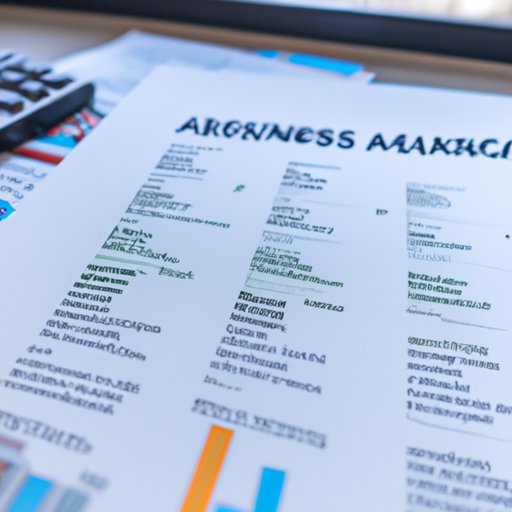Introduction
A business financial statement is a document that portrays the financial health of a company. It is used by investors, lenders, and creditors to make decisions about investing in, lending to, or extending credit to the business. This article will provide an overview of business financial statements, their key components, benefits, accounting principles, types, and steps for creating them from scratch.

Key Components of a Business Financial Statement
A business financial statement is composed of five main components: revenues, expenses, assets, liabilities, and equity. These components are essential for understanding the financial position of a business.
Revenues
Revenues are the income generated by a business from its operations. They are usually recorded as sales revenue, service revenue, interest revenue, and other revenue. Revenues are important because they represent the amount of money a business has available to pay its expenses.
Expenses
Expenses are the costs incurred by a business in order to generate revenue. They are typically recorded as cost of goods sold, operating expenses, interest expenses, and other expenses. Expenses are important because they represent the amount of money a business has to spend in order to generate revenue.
Assets
Assets are items of value owned by a business. They are typically recorded as current assets, such as cash and accounts receivable, and long-term assets, such as property and equipment. Assets are important because they represent the resources a business uses to generate revenue.
Liabilities
Liabilities are obligations owed by a business to another party. They are typically recorded as current liabilities, such as accounts payable and short-term debt, and long-term liabilities, such as long-term debt. Liabilities are important because they represent the amount of money a business owes to another party.
Equity
Equity is the difference between a business’s assets and liabilities. It represents the ownership stake of the owners of the business. Equity is important because it represents the net worth of the business.
Benefits of Business Financial Statements
Business financial statements provide a clear picture of the financial health of a business. They can help improve decision-making, enable better planning and budgeting, and increase efficiency. By having access to accurate financial information, businesses can make more informed decisions, plan for future growth, and ensure they are using their resources in the most efficient way possible.
Accounting Principles Used in Preparing a Business Financial Statement
When preparing a business financial statement, it is important to use the appropriate accounting principles. The two most commonly used sets of accounting principles are Generally Accepted Accounting Principles (GAAP) and International Financial Reporting Standards (IFRS). GAAP is the set of standards used in the United States, while IFRS is used in Europe and many other countries around the world.
Types of Financial Statements
There are three main types of financial statements: the income statement, the balance sheet, and the cash flow statement. The income statement shows a business’s revenues and expenses over a period of time. The balance sheet shows a business’s assets, liabilities, and equity at a specific point in time. The cash flow statement shows a business’s inflows and outflows of cash over a period of time.

Steps for Creating a Business Financial Statement from Scratch
Creating a business financial statement from scratch requires gathering financial data, analyzing the data, recording transactions, and then preparing the financial statements. The first step is to gather all the necessary financial data, including income statements, balance sheets, and cash flow statements. Next, analyze the data to identify trends and patterns. Then record all the relevant transactions in the appropriate accounts. After that, prepare the income statement, balance sheet, and cash flow statement.

Examples of Completed Business Financial Statements
The following example shows a completed business financial statement for a fictitious company called ABC Co. The income statement shows total revenues of $100,000 and total expenses of $50,000, resulting in a net income of $50,000. The balance sheet shows total assets of $150,000 and total liabilities of $50,000, resulting in total equity of $100,000. Lastly, the cash flow statement shows total cash inflows of $60,000 and total cash outflows of $40,000, resulting in a net cash flow of $20,000.
Conclusion
Business financial statements are an important tool for understanding the financial health of a business. They provide detailed information about a business’s revenues, expenses, assets, liabilities, and equity. Furthermore, they can be used to improve decision-making, better plan and budget, and increase efficiency. In order to create a business financial statement from scratch, one must gather financial data, analyze the data, record transactions, and then prepare the financial statements. With this information, one should be able to create a comprehensive and accurate business financial statement.
(Note: Is this article not meeting your expectations? Do you have knowledge or insights to share? Unlock new opportunities and expand your reach by joining our authors team. Click Registration to join us and share your expertise with our readers.)
